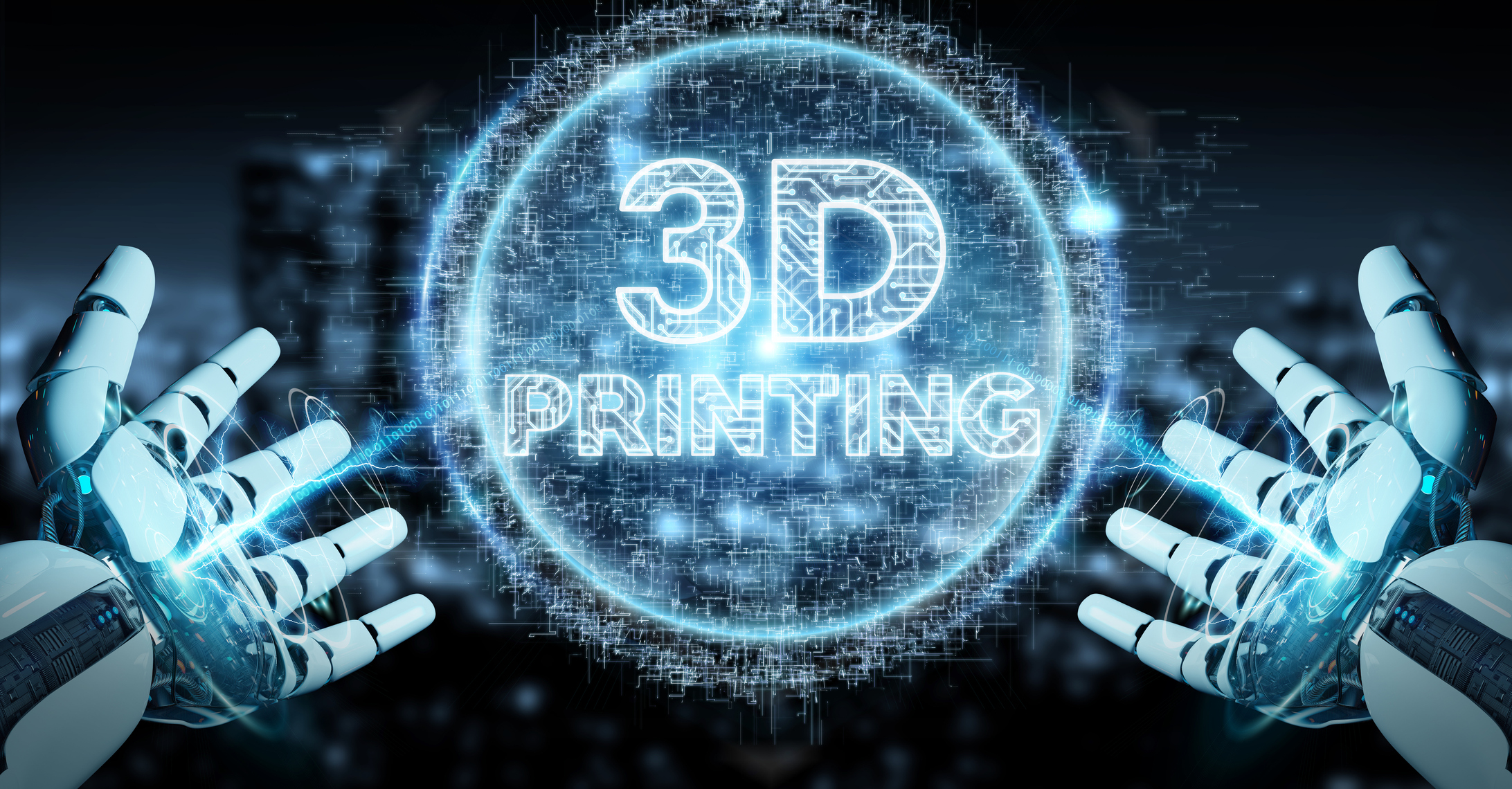เชื่อหรือไม่? การพิมพ์ 3 มิติไม่ใช่เรื่องใหม่อย่างที่คุณคิด แนวคิดของการพิมพ์ 3 มิติมีขึ้นในปี 1945 และเริ่มปฏิบัติมาตั้งแต่ปี 1971 อย่างไรก็ตาม ความพยายามในการพิมพ์ 3 มิติครั้งแรกเกิดขึ้นในปี 1981 โดย Dr. Kodama ที่ต้องการจะพัฒนาเทคนิคการสร้างต้นแบบอย่างรวดเร็ว และยังเป็นคนแรกที่อธิบายแนวทางการผลิตแบบทีละชั้น นอกเหนือจากการผลิตแบบเติมเนื้อวัสดุแล้ว การพิมพ์ 3 มิติยังถูกนำมาใช้อย่างแพร่หลายในอุตสาหกรรมต่างๆ เช่น การก่อสร้าง สถาปัตยกรรม การออกแบบผลิตภัณฑ์ อุปกรณ์ทางการแพทย์ และอวัยวะเทียม เป็นต้น




Source: Behance.Net
จากข้อมูลของ Statista ตลาดการผลิตสารเติมแต่งทั่วโลกคาดว่าจะเติบโต 17% ต่อปีจนถึงปี 2566 ทั้งนี้เนื่องจากการใช้งานด้านเทคโนโลยีเพิ่มขึ้นและสารเติมแต่งโลหะมีศักยภาพมากขึ้นเรื่อยๆ ยิ่งไปกว่านั้น ตลาดผลิตภัณฑ์และบริการสำหรับการผลิตสารเติมแต่งคาดว่าจะเพิ่มขึ้นเกือบสามเท่าในระหว่างปี 2020 และ 2026 ปัจจุบันการผลิตสารเติมแต่งเป็นเทคโนโลยีที่พัฒนาเต็มที่แล้ว ความสนใจของผู้บริโภคและความแข็งแกร่งของฝากฝั่งอุตสาหกรรม ซึ่งต่างเติบโตในทศวรรษ 2010s มาโดยตลอด ซึ่งอาจทำให้คิดไปได้ว่าสารเติมแต่งจะเข้ามาแทนที่การผลิต CNC และการกัดแบบดั้งเดิมนั้น อาจเนื่องมาจากรายงานของ Lux Research ที่คาดการณ์มูลค่าตลาดการพิมพ์ 3 มิติจะนี้จะสูงถึง 51 พันล้านเหรียญสหรัฐฯ ภายในปี 2030
ตามรายงานของ AMPOWER ปี 2023 กล่าวว่าตลาดการผลิตสารเติมแต่งโลหะทางอุตสาหกรรมเติบโตมากกว่า 20% ในปี 2022 ซึ่งเมื่อเทียบกับผลิตภัณฑ์โพลีเมอร์แล้วก็ถือว่าสูสี อย่างไรก็ตาม ตลาดโพลิเมอร์ AM ยังคงสร้างรายได้มากกว่าสองเท่าในระยะยาว ตลาดโลหะคาดว่าจะเติบโตมากกว่าสองเท่าของตลาดโพลิเมอร์จนถึงปี 2027 มูลค่าของตลาดโลหะ AM เพียงลำพังนั้นมีมากกว่า 3.30 พันล้านเหรียญสหรัฐในปี 2022 และคาดว่าจะมีอัตราการเติบโตเฉลี่ยต่อปีเกือบ 30% ต่อปี ซี่งเริ่มต้นที่ 7.14 พันล้านเหรียญฯ ในปี 2022

Source: Additive Manufacturing Report, AMPOWER
การผลิตแบบเติมเนื้อวัสดุถูกนำมาใช้อย่างแพร่หลายในหลายอุตสาหกรรม โดยอุตสาหกรรมการบินและอวกาศเป็นประเทศแรกที่ยอมรับการพิมพ์ 3 มิติ สำหรับการดูแลสุขภาพ อุปกรณ์ทางการแพทย์ และ ทันตกรรม ต่างใช้การพิมพ์ 3 มิติเพื่อสร้างชิ้นงานต่างๆ เช่น ฟันเทียม อินเลย์ และรากฟันเทียมอื่นๆ การพิมพ์ 3 มิติสร้างวัตถุสามมิติโดยการเพิ่มวัสดุเป็นชั้น ๆ จนมีรูปทรงตามที่ได้ออกไว้โดยซอฟต์แวร์เพื่องานออกแบบ (CAD) การพิมพ์ 3 มิตินี้เรียกอีกอย่างว่าการผลิตแบบเพิ่มเนื้อวัสดุ (AM) ช่วยให้ผลิตชิ้นส่วนแบบกำหนดเองที่ มีรูปทรงเรขาคณิตที่ซับซ้อน และเกิดความสูญเสียวัสดุน้อยที่สุด จึงช่วยลดต้นทุนของชิ้นส่วนที่มีมูลค่าสูง อีกทั้งช่วยให้ปรับเปลี่ยนการออกแบบได้อย่างรวดเร็ว และด้วยประสิทธิภาพในระหว่างกระบวนการผลิตนี้เองที่ลดเวลาในการผลิต เทคโนโลยียังทำให้สามารถสร้างสิ่งต่าง ๆ ที่เคยจำเป็นต้องประกอบจากหลาย ๆ ชิ้นให้เป็นชิ้นงานเดียวกัน ซึ่งช่วยเพิ่มความแข็งแกร่ง และอายุการใช้งานให้ยาวนานขึ้น ตลาดการผลิตสารเติมแต่งและวัสดุมีการแข่งขันค่อนข้างสูง ผู้เล่นหลักที่มีส่วนแบ่งการตลาดที่สำคัญกำลังมุ่งเน้นไปที่การพัฒนาความสามารถในการออกแบบเชิงสร้างสรรค์สำหรับเทคนิคการพิมพ์ 3 มิติ และเมื่อเพิ่มความสามารถของซอฟต์แวร์ที่ปรับให้เหมาะกับการผลิตแบบเติมเนื้อวัสดุแล้ว ผู้ประกอบการจะสามารถเพิ่มฐานลูกค้าในตลาดต่างประเทศ อีกทั้งยังจะร่วมงานกันเชิงกลยุทธ์ เพื่อเพิ่มส่วนแบ่งการตลาดและความสามารถในการทำกำไร

คาดว่าภูมิภาคเอเชียแปซิฟิกจะมีอัตราการเติบโตที่สำคัญ โดยจีนตั้งเป้าเพิ่มขีดความสามารถในการแข่งขันอุตสาหกรรมตามยุทธศาสตร์ “Made in China 2025” ด้วยการลงทุนในเทคโนโลยีที่ล้ำสมัย เช่น การพิมพ์ 3 มิติ และจัดเตรียมกำลังคนในอนาคต การสำรวจที่จัดทำโดยบริษัทเทคโนโลยีการพิมพ์ 3 มิติ “Materialise” ระบุว่า 30% ของกลุ่มบริษัทผู้ผลิตของจีน มีวิสัยทัศน์ร่วมว่าการพิมพ์ 3 มิติจะมีความสำคัญมากกว่าการผลิตแบบดั้งเดิม ในขณะเดียวกันเทคนิค 3D bio-printing กำลังพัฒนาโดย Pohang University of Science and Technology (POSTECH) ของเกาหลีใต้ เพื่อการวิศวกรรมอวัยวะเสมือนจริง ตามข้อมูลของสถาบันวิจัยบ่งชี้ การสร้างอวัยวะทดแทนที่มีความซับซ้อนมากแบบอัตโนมัตินั้นเป็นไปได้เมื่อสามารถบูรณาการการพิมพ์ 3 มิติ เข้ากับ เทคโนโลยี AI และหุ่นยนต์ พัฒนาการแบบ้าวกระโดยเช่นนี้ยังพบได้ในประเทศญี่ปุ่น เช่น เครือบริษัทของญี่ปุ่น เช่น JGC Holdings Corporation ได้ติดตั้งเครื่องพิมพ์ COBOD 3D ในงานก่อสร้าง พบว่าเทคโนโลยี COBOD ช่วยลดเวลาในการสร้างแบบหล่อขึ้นรูปได้อย่างมาก ซึ่งจากกรคำนวณพบว่าการพิมพ์ 3 มิติ อาจสามารถลดขั้นตอนการทำงาน จากเดิมใช้เวลาถึง 16 วันให้เหลือเพียง 8 วัน

Source: Mordor Intelligence
นอกจากนี้ การพัฒนาล่าสุดพบว่าการผลิตแบบกระจายและการผลิตแบบเติมเนื้อวัสดุ หรือที่เรียกว่าการพิมพ์ 3 มิติ เป็นส่วนผสมที่ทรงพลัง เพื่อแก้ปัญหาความท้าทายในห่วงโซ่อุปทาน ด้วยเหตุนี้ บริษัทชั้นนำบริหารจัดการความเสี่ยงด้านอุปทานจากการกระจายการผลิตตามพื้นที่ทางภูมิศาสตร์ พิจารณารูปแบบการใช้งาน พบว่า กระบวนการผลิตแบบเติมเนื้อวัสดุนั้น เหมาะสมกับการผลิตที่ลักษณะเป็นชุดเล็ก จำนวนไม่มาก การพิมพ์ 3 มิติสำหรับการผลิตแบบกระจาย จะเป็นประโยชน์สูงสุดสำหรับการผลิตชิ้นส่วนที่มีมูลค่าสูง เช่น ชิ้นส่วนที่ใช้ในอุตสาหกรรมการบินและอวกาศและเทคโนโลยีทางการแพทย์ หรือชิ้นส่วนอะไหล่ที่มีปริมาณน้อย สิ่งเหล่านี้เป็นหนึ่งในการประยุกต์ใช้เทคโนโลยีแห่งการเปลี่ยนแปลงที่ประกอบกันเป็นอุตสาหกรรม 4.0

Source: ACAM Aachen Center for Additive Manufacturing, BCG.
บริษัทล้วนหาวิธีป้องกันภาวะชะงักงันจากความล่าช้าที่เกิดในกระบวนการจัดส่งกระจายสินค้า หรือหลีกเลี่ยงต้นทุนที่สูงขึ้นจากการสรรหาตัวเลือกการขนส่ง ชุดวิธีแก้ไขปัญหาหนึ่งที่น่าสนใจ คือ การออกแบบห่วงโซ่อุปทานและเครือข่ายการผลิต ไปสู่การผลิตแบบกระจายศูนย์ รายงานจาก BCG เสนอว่า เพื่อลดความเสี่ยงในห่วงโซ่อุปทานที่เฉพาะเจาะจง ผู้ผลิตสามารถกระจายการผลิตโดยประยุกต์วิธีการ 3 มิติ โดยอาจนำไปใช้เพียงมิติเดียว บางมิติ หรือผสมผสานทุกมิติรวมกัน
ผู้ผลิตสามารถรวม รูปแบบการผลิตแบบกระจาย เข้ากับการผลิตแบบเติมเนื้อวัสดุ เพื่อลดความเสี่ยงในห่วงโซ่อุปทาน วิธีการแบบผสมผสานจะช่วยให้บริษัทเกิดความความยืดหยุ่น เกิดความความยั่งยืน และสร้างคุณค่าให้กับธุรกิจ ความสำเร็จของการประยุกต์ใช้เทคโนโลยี ขึ้นอยู่กับว่าเมื่อประเมินแล้ว เทคโนโลยีการผลิตแบบเติมเนื้อวัสดุนั้นนำไปสู่กรณีการใช้งานการผลิตแบบกระจายสามมิติ ที่ก่อให้เกิดความคุ้มค่าทางเศรษฐศาสตร์ได้อย่างไร เมื่อคำนึงถึงความท้าทายที่มีเข้ามาในห่วงโซ่อุปทานอย่างต่อเนื่อง ทุกผู้ผลิตควรพิจารณาเลือก แนวทางวิธีการผลิตแบบกระจายด้วยการพิมพ์ 3 มิติ ที่ส่งเสริมศักยภาพของธุรกิจตนเอง

Source: ACAM Aachen Center for Additive Manufacturing, BCG
Article by: Asst. Prof. Suwan Juntiwasarakij, Ph.D., Senior Editor












